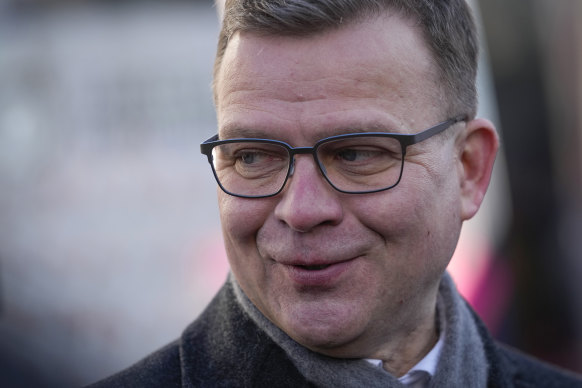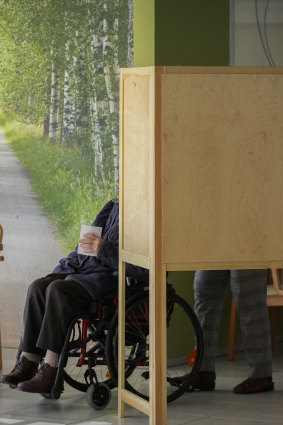
Helsinki: Finnish Prime Minister Sanna Marin was projected to lose in the Nordic country’s close parliamentary elections.
Running neck-and-neck with opposition centre-right National Coalition, the millennial leader’s Social Democrats were seen falling to third place, according to a projection of the results by state broadcaster YLE.
Finnish Prime Minister Sanna Marin, Social Democratic Party chair, reacts as she watches result]s of exit polls in Helsinki, Finland.Credit:AP
The prediction attempts to even out the disparities in the speed of counting in smaller municipalities and the big cities.
The projection gave Marin’s SDP 43 seats, behind both the National Coalition with 48 seats and the far-right Finns Party with 46 seats.
The winner — and the coalition they put together — will shape the trajectory of Finland’s public finances, the fate of its ambitious 2035 net zero goal and prospects to offset population ageing with immigration into the cold, northernly nation.
Chairman of the National Coalition Party Petteri Orpo.Credit:AP
Should the pro-business National Coalition of Petteri Orpo finish first, that would mirror the shift in neighbouring Sweden where a more inward-looking and fiscally conservative government, led by the Moderate Party, took power from the Social Democrats last year.
“We must fix our economy,” Orpo told reporters. “We are a clear alternative to the left-wing government. People are very worried about the economy.”
Marin’s support stems from her handling of both an unprecedented pandemic and the fallout of Russia’s war in Ukraine, which led to Finland’s bid to join NATO. She has garnered international fame as head of a five-party cabinet led solely by women, with the 37-year-old premier’s personal lifestyle drawing in young voters.
Her backing also shows many voters are prepared to shrug off the country’s continued borrowing, after 15 years of budgets in the deficit, as Marin’s party rejects spending reductions.
A voter leaves a polling booth at a polling station in Turku, Finland.Credit:AP
Marin has sought to stay in power with pledges to raise taxes and foster growth — means that the opposition National Coalition say are mutually exclusive. Orpo’s party campaigned instead on the platform of lower taxes and reduced spending with a goal of balancing the books sooner.
Opposition ultra-nationalist Finns Party of Riikka Purra agrees on fiscal prudence, attracting voters concerned over internal security and immigration, and who think too much fuss is being made of climate change. It also channels the anti-establishment vote.
What those clashing views mean for post-election coalition building is shrouded in mystery, complicating the choice for 4.3 million eligible voters in Finland, where set political blocs don’t exist.
As a rule, the party with the most seats in parliament gets the first attempt to form a ruling coalition — and cabinets can even be formed by parties from opposite sides of the political spectrum if they manage to agree on a joint policy program. The talks can kick off after the election of a parliament speaker April 12 and are set to take weeks, if not months.
Among the few red lines disclosed ahead of the vote, many parties refuse to work with the nationalists, with Orpo’s National Coalition an exception. The Center Party of Finance Minister Annika Saarikko has ruled out extending the current coalition with Marin’s party for another term.
Finland’s upcoming membership in NATO is among the few issues that’s widely backed across the political spectrum.
Bloomberg
Get a note directly from our foreign correspondents on what’s making headlines around the world. Sign up for the weekly What in the World newsletter here.
Most Viewed in World
From our partners
Source: Read Full Article


